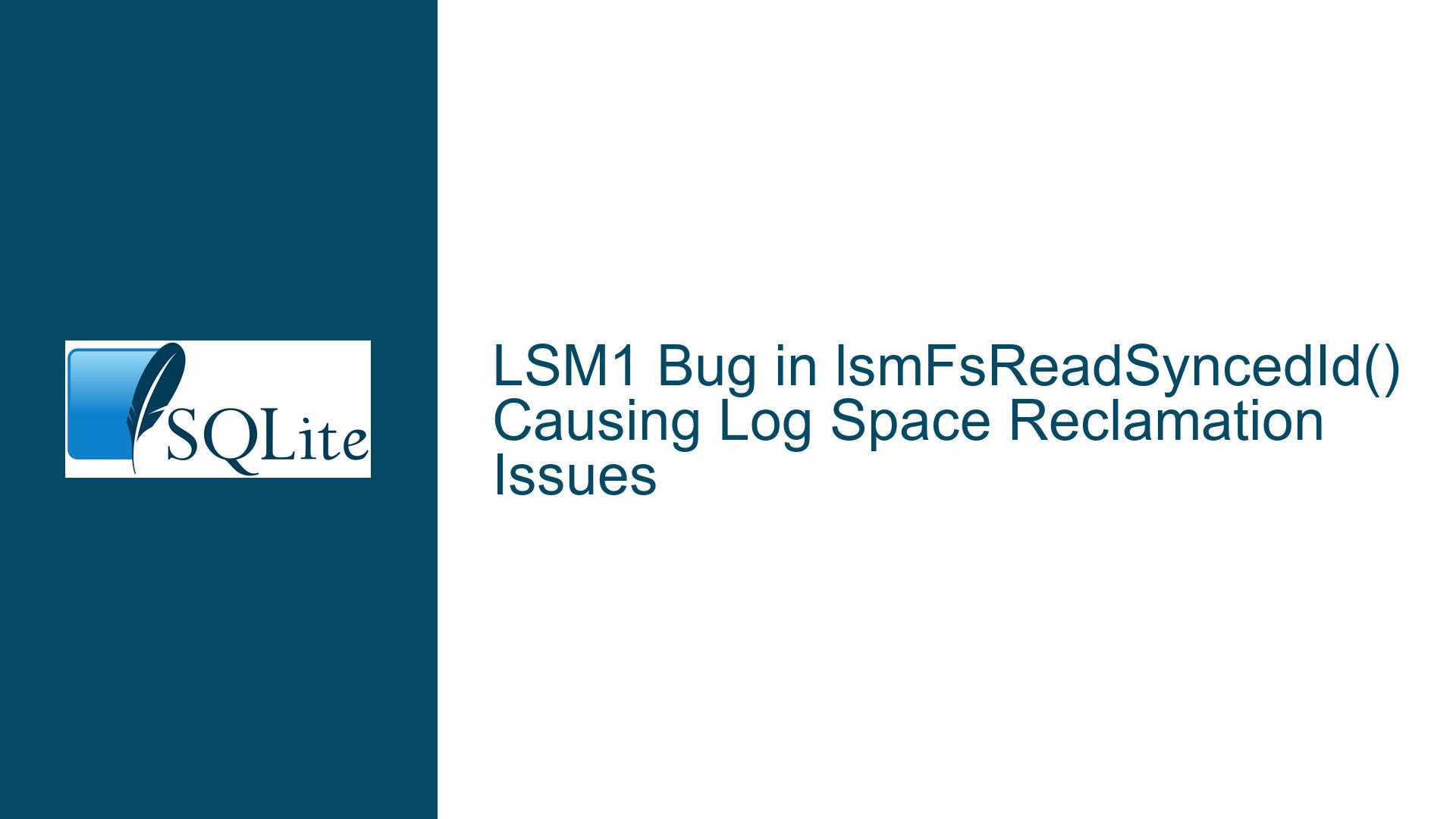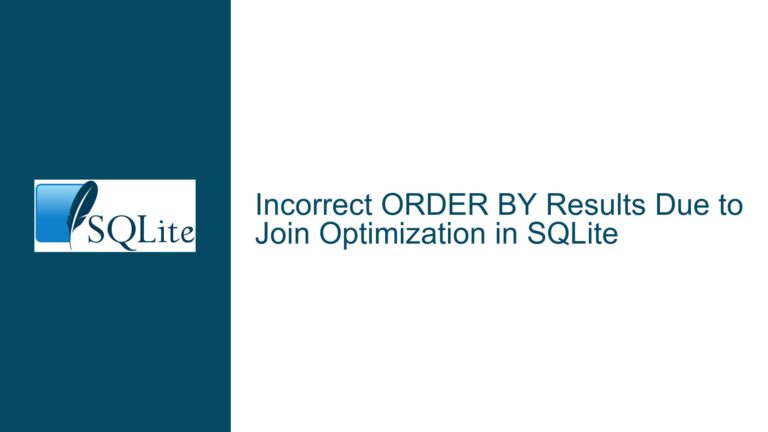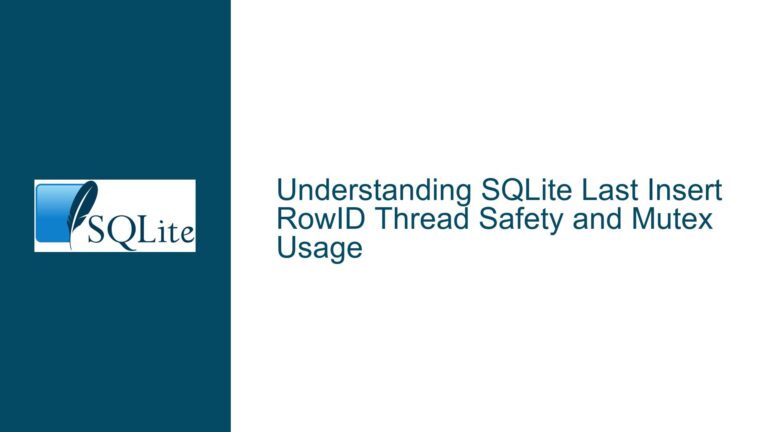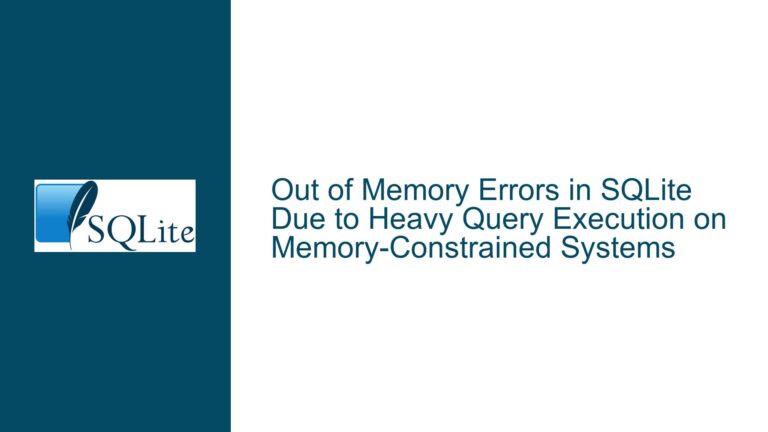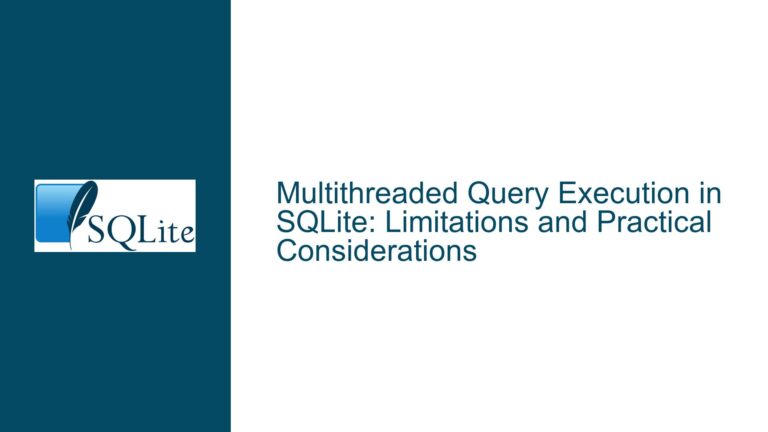LSM1 Bug in lsmFsReadSyncedId() Causing Log Space Reclamation Issues
Issue Overview: LSM1 Log Space Reclamation Due to Incorrect Synced ID Handling
The core issue revolves around the lsmFsReadSyncedId() function in the LSM1 storage engine, which is responsible for reading the synced snapshot ID from the database metadata. The bug manifests when the function incorrectly reads the synced ID, leading to a persistent mismatch between the pLog->iSnapshotId and iSyncedId values. This mismatch triggers the logReclaimSpace() function to continuously reclaim log space, even when it is unnecessary. The root cause lies in the way the synced ID is read from the metadata, particularly in non-memory-mapped (non-mmapped) scenarios.
The synced ID (iSyncedId) is a critical component in the LSM1 logging mechanism. It represents the last known snapshot ID that has been successfully synced to disk. When a new snapshot is created, its ID is compared to the synced ID to determine whether the log space can be reclaimed. If the IDs match, it indicates that the log data associated with the snapshot has been fully synced and can be safely reclaimed. However, due to the bug in lsmFsReadSyncedId(), the comparison pLog->iSnapshotId != iSyncedId always evaluates to true, causing the log space reclamation process to run unnecessarily.
The incorrect handling of the synced ID is particularly evident in the non-mmapped path of the lsmFsReadSyncedId() function. The function attempts to read a 64-bit integer (i64) from the metadata buffer (pMeta->aData). However, the current implementation uses a direct cast to u64, which may not handle endianness correctly, especially on big-endian systems. This leads to an incorrect value being assigned to *piVal, which is then used as the synced ID. As a result, the synced ID does not match the actual snapshot ID (pDb->pClient->iId), causing the log space reclamation process to be triggered repeatedly.
Possible Causes: Endianness and Memory Alignment Issues in Synced ID Reading
The primary cause of the issue is the incorrect handling of endianness and memory alignment when reading the synced ID from the metadata buffer. The current implementation in lsmFsReadSyncedId() uses a direct cast to u64 to read the 64-bit integer from the metadata buffer. This approach assumes that the data is stored in a format that is compatible with the host system’s endianness. However, this assumption may not hold true, especially on big-endian systems, where the byte order is reversed compared to little-endian systems.
In addition to endianness issues, the current implementation also includes an assertion that checks whether the metadata buffer is aligned to a 4-byte boundary (assert( 0==((u64)pMeta->aData % 4) );). This assertion is based on the assumption that the buffer is properly aligned, which may not always be the case. If the buffer is not aligned, the cast to u32* could result in undefined behavior, leading to incorrect values being read from the buffer.
The proposed fix addresses these issues by replacing the direct cast to u64 with a more robust approach that explicitly handles endianness and memory alignment. The new implementation reads the 64-bit integer as two 32-bit integers (u32), shifts the first integer by 32 bits, and combines it with the second integer using a bitwise OR operation. This approach ensures that the correct value is read from the metadata buffer, regardless of the system’s endianness.
Another potential cause of the issue is the lack of proper synchronization between the synced ID and the snapshot ID. The synced ID is supposed to represent the last known snapshot ID that has been successfully synced to disk. However, if the synced ID is not updated correctly, it can lead to a mismatch between the synced ID and the snapshot ID. This mismatch can occur if the synced ID is not updated atomically or if there is a race condition between the syncing process and the snapshot creation process.
Troubleshooting Steps, Solutions & Fixes: Correcting Synced ID Handling and Preventing Log Space Reclamation Issues
To resolve the issue, the lsmFsReadSyncedId() function must be modified to correctly handle endianness and memory alignment when reading the synced ID from the metadata buffer. The following steps outline the necessary changes and provide a detailed explanation of the solution:
Replace the Direct Cast to
u64with a Robust Endianness-Aware Implementation:
The current implementation uses a direct cast tou64to read the 64-bit integer from the metadata buffer. This approach is problematic because it does not account for endianness differences between systems. To address this, the function should be modified to read the 64-bit integer as two 32-bit integers (u32), shift the first integer by 32 bits, and combine it with the second integer using a bitwise OR operation. This ensures that the correct value is read from the metadata buffer, regardless of the system’s endianness.The modified code should look like this:
u32 *pInt = (u32 *)pMeta->aData; *piVal = ((i64)pInt[0] << 32) | (i64)pInt[1];This approach explicitly handles endianness by reading the 64-bit integer as two 32-bit integers and combining them in a way that is independent of the system’s byte order.
Remove the Alignment Assertion and Ensure Proper Memory Alignment:
The current implementation includes an assertion that checks whether the metadata buffer is aligned to a 4-byte boundary (assert( 0==((u64)pMeta->aData % 4) );). This assertion is based on the assumption that the buffer is properly aligned, which may not always be the case. To avoid potential issues with memory alignment, the assertion should be removed, and the function should be modified to ensure that the buffer is properly aligned before reading the 64-bit integer.If the buffer is not guaranteed to be aligned, the function should use a memory copy operation (
memcpy) to read the 64-bit integer from the buffer. This approach ensures that the data is read correctly, even if the buffer is not aligned.The modified code should look like this:
u32 pInt[2]; memcpy(pInt, pMeta->aData, sizeof(pInt)); *piVal = ((i64)pInt[0] << 32) | (i64)pInt[1];This approach ensures that the data is read correctly, regardless of the buffer’s alignment.
Ensure Proper Synchronization Between the Synced ID and the Snapshot ID:
To prevent mismatches between the synced ID and the snapshot ID, the synced ID must be updated atomically and in a way that ensures proper synchronization with the snapshot creation process. This can be achieved by using atomic operations or locks to ensure that the synced ID is updated correctly.If the synced ID is updated asynchronously, it is important to ensure that the update is completed before the snapshot ID is compared to the synced ID. This can be achieved by using a memory barrier or a synchronization primitive to ensure that the update is visible to all threads.
Additionally, the synced ID should be updated only after the snapshot has been successfully synced to disk. This ensures that the synced ID accurately reflects the last known snapshot ID that has been synced.
Test the Fix on Both Little-Endian and Big-Endian Systems:
After implementing the fix, it is important to test the modifiedlsmFsReadSyncedId()function on both little-endian and big-endian systems to ensure that the synced ID is read correctly in all cases. This can be done by running the LSM1 storage engine on different architectures and verifying that the log space reclamation process behaves as expected.If the fix is not tested on both types of systems, there is a risk that the issue could persist on big-endian systems, leading to continued log space reclamation issues.
Monitor Log Space Reclamation Behavior After Applying the Fix:
After applying the fix, it is important to monitor the log space reclamation behavior to ensure that the issue has been resolved. This can be done by enabling logging or debugging output in the LSM1 storage engine and verifying that thelogReclaimSpace()function is no longer triggered unnecessarily.If the log space reclamation process continues to run unnecessarily, it may indicate that there are other issues in the LSM1 storage engine that need to be addressed.
By following these steps, the issue with the lsmFsReadSyncedId() function can be resolved, preventing unnecessary log space reclamation and ensuring that the LSM1 storage engine operates correctly on both little-endian and big-endian systems. The fix addresses the root cause of the issue by correctly handling endianness and memory alignment when reading the synced ID from the metadata buffer, and by ensuring proper synchronization between the synced ID and the snapshot ID.
